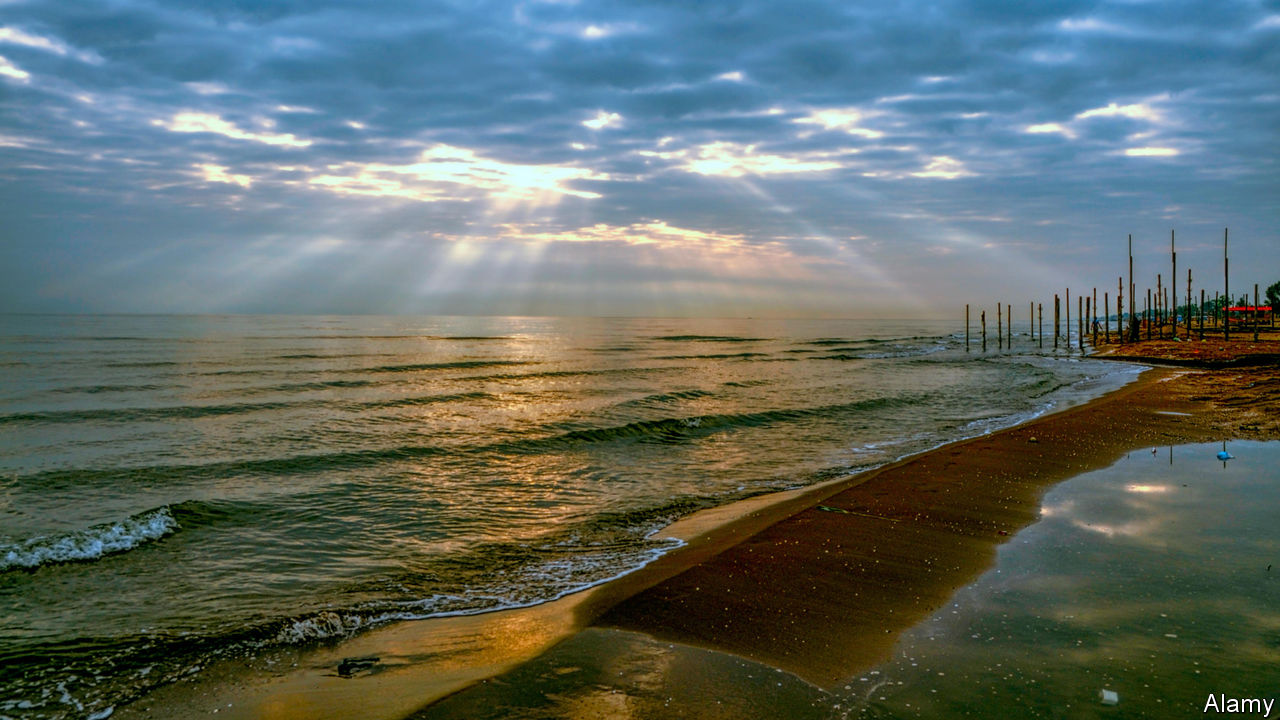 WHAT is the Caspian? For 20 years Azerbaijan, Iran, Kazakhstan, Russia and Turkmenistan, which surround it, have disagreed over whether it is a lake or a sea. Like many lakes, it does not feed into an ocean, but it is sea-like in its size and depth. The distinction is not merely semantic, but has economic, military and political implications. Lakes’ surfaces and beds are divided up equally by bordering countries. Seas are governed by the UN’s Law of the Sea. The surface and bed are allotted, nearer to shore, according to the length of relevant coastline. When Iran and the USSR were the only two countries to border the Caspian, a series of bilateral treaties identified it as a lake that they divided equally. Iran, which has a short Caspian coast, still prefers this idea. Kazakhstan, which has the longest shore on the Caspian, is among the countries that prefer to call it a sea.
WHAT is the Caspian? For 20 years Azerbaijan, Iran, Kazakhstan, Russia and Turkmenistan, which surround it, have disagreed over whether it is a lake or a sea. Like many lakes, it does not feed into an ocean, but it is sea-like in its size and depth. The distinction is not merely semantic, but has economic, military and political implications. Lakes’ surfaces and beds are divided up equally by bordering countries. Seas are governed by the UN’s Law of the Sea. The surface and bed are allotted, nearer to shore, according to the length of relevant coastline. When Iran and the USSR were the only two countries to border the Caspian, a series of bilateral treaties identified it as a lake that they divided equally. Iran, which has a short Caspian coast, still prefers this idea. Kazakhstan, which has the longest shore on the Caspian, is among the countries that prefer to call it a sea.
The Caspian basin and surrounding area are rich in hydrocarbons, which include 48bn barrels of oil and over 8 trillion cubic metres of gas, according to the US Energy Information Administration. The surrounding countries already exploit the reserves close to their coasts, where jurisdiction is the same regardless of whether the Caspian is a lake or a sea. But many hydrocarbon deposits in the south of the Caspian are disputed by Azerbaijan, Iran and Turkmenistan. In addition, Turkmenistan, with the world’s fourth-largest gas reserves, hopes to construct a Trans-Caspian Pipeline to export gas to Europe. Russia has long opposed the pipeline. It cites environmental concerns, but may be rather more motivated by a desire to maintain its market dominance.
On August 12th the leaders of the five Caspian countries met in the Kazakh city of Aqtau to determine the water’s status. The resulting Convention on the Legal Status of the Caspian Sea was a compromise. Despite its name, it determines that the Caspian is neither lake nor sea. The surface is to be treated as a sea, with states granted jurisdiction over 15 nautical miles of water from their coasts and fishing rights over an additional ten miles. But the seabed and its lucrative mineral deposits are not allocated in precise form. This division of the spoils is left to countries to agree on a bilateral basis. The convention also permits the construction of pipelines, which only require the approval of the countries whose seabed they cross, subject to environmental provisions, and forbids non-Caspian countries from deploying military vessels in the water.
The convention most clearly benefits Russia in the short term. Russia secures the dominance of its Caspian Sea fleet, from which it has launched missiles at targets in Syria. The convention also serves as a show of Russo-Iranian co-operation in the face of American sanctions, and lets Russia reassert its ties to Caspian states in the context of rising Chinese influence in the region. The convention’s benefits for the other Caspian states are more ambiguous. Kazakhstan will benefit from a firmer framework for the jurisdiction of its offshore Kashagan oil field, but that is already in operation. The feasibility of trans-Caspian pipelines, taking oil from Kazakhstan and gas from Turkmenistan to Azerbaijan, was reaffirmed, though these were technically already permissible under international law. It is unclear if the other Caspian states are still able to prevent their construction by citing environmental concerns. But a resolution of the disputed area in the southern Caspian remains elusive. The Iranian president, Hassan Rouhani, made clear that more agreements are required to divide the seabed into territorial zones. The Caspian’s surface may be closer to a sea, but the fate of the subsoil remains a work in progress.
No comments:
Post a Comment